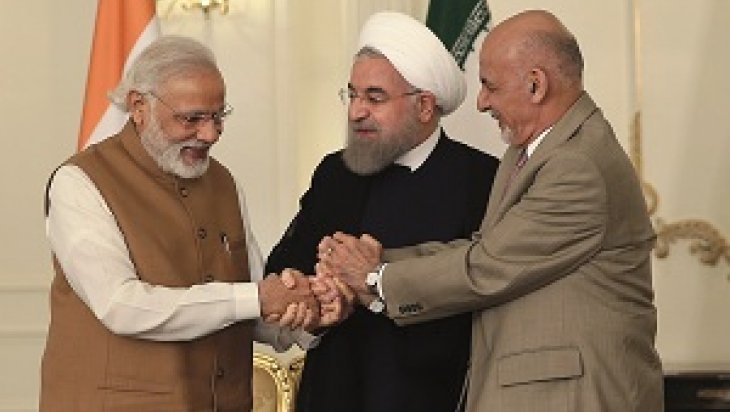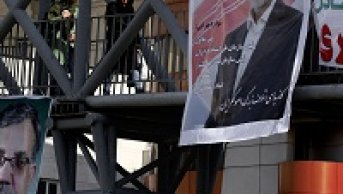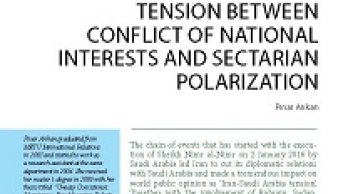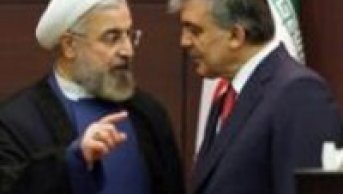Chabahar Agreement: Iran-India-Afghanistan Spring

Chabahar is a port city that is located in the southeast Iran on the shore of Gulf of Oman. According to one account, the city has been named as ‘Chabahar’, meaning ‘four springs’since temperature changes in the area remain at a minimum level and spring goes on four seasons. Iranian President Rouhani defined the Chabahar Agreement that was reached between Iran-India-Afghanistan on 23 May 2016 also as ‘the spring of three countries.’ According to Rouhani, this agreement was not only an economic agreement but also a political document and it gave the message to the world that ‘regional countries used regional opportunities again for their region.’ The agreement, which foresees 500-million-dollar investment of India to Chabahar port, aims at linking India and Afghanistan through Iran both by sea and land routes. Therefore, Iran committed to provide a ‘safe’ connection for India to Central Asia and Caucasia.
Although Iran-India strategic cooperation has not been a recent issue, the trilateral agreement that was signed on 23 May shows that this cooperation has taken a regional dimension. The first steps for strategic cooperation between Iran and India were Tehran Declaration of 20 April 2001 and New Delhi Declaration of 25 January 2003. The New Delhi Declaration that was signed during the visit of then-President of Iran Muhammad Khatami to India projected strengthening not only bilateral trade relations but also military relations. The New Delhi Declaration emphasized on issues such as increasing trade in goods other than hydro-carbon, development of Chabahar port complex by joint venture, India-Iran strategic dialogue, institutional communication regarding national security concerns. The declaration also envisaged the extension of bilateral strategic cooperation to third parties, such as Afghanistan. The Chabahar Agreement of 23 May signed between Iran, India and Afghanistan can also be understood as the realization of 2003 goals.
Iran-India Relations
After the establishment of Islamic Republic in 1979, the first official intercourse between Iran and India was Indian Prime Minister Shri Narasimha’s visit to Iran in 1993. In 1995, Iranian President Hashemi Rafsanjani visited India, andone year after Indian Vice-President Shri R. K. Narayanan visited Iran. In 2001, after Indian Prime Minister Atal Bihari Vajpayee’s visit to Tehran, the issue strategic cooperation between the two countries came to the fore.India-Iran Strategic Dialogue mechanism that was formed in 2001 and regular meetingsbetween the foreign affairs representatives of the two countries continued until 2005.The ‘New Delhi Declaration,’ which was signed during the visit of Iranian President Khatami to India in January 2003, put forward strategic partnership vision for a more stable, secure and prosperous region and strong regional and global cooperation. Iranian President Ahmadinejad visited India within the framework of his ‘Look to the East ‘policy on 29 April 2008. Ahmadinejad’s visit precipitated the bilateral relations and the two countries started to engage in regular meetings through the consultative mechanisms formedat this visit.
However, the ongoing dialogue between the two countries was not immune from difficulties. The civil nuclear cooperation framework agreement that India signed with the USA in July 2005 overshadowed Iran-India relations. Within the framework of this agreement that was signed on the basis of strategic partnership the USA promised India tolessen its energy dependency on ‘unstable’ states such as Iran. On 24 September 2005, while International Atomic Energy Agency (IAEA) was discussing the implementation of nuclear non-proliferation measures convention on Iran, India voted for it alongside the USA. Although India claimed that the aim of this vote was to prevent a possible conflict between Iran and international community, Iran perceived it as a step-back in bilateral relations. When India voted against Iran once more inFebruary 2006 in the discussion of sending Iranian nuclear dossier from IAEA to UN Security Council, Iran got disappointed. Although relations warmed up with Ahmadinejad’s 2008 visit, India’s collaboration in implementation of nuclear sanctions for the sake of preserving its trade and strategic relations with the West led to a halt in bilateral cooperation. Upon the conclusion of Joint Comprehensive Plan of Action (JCPAO) between P5+1 and Iran on 14 July 2015, two countries has taken action for strategic cooperation.
The Process Leading to the Chabahar Agreement
The process leading to the Chabahar Agreement between Iran-India-Afghanistan on 23 May 2016 was accelerated with the start of nuclear negotiations between Iran and P5+1. This process had two dimensions, which were energy and trade.
The first effect of nuclear negotiations on Iran-India trade relations was the increasing oil trade. Iran was the second largest oil supplier of India before 2012 but fall back to seventh in 2012-2013. Following the termination of sanctions Iran raised to fifth largest oil supplier of India in December 2015. Alongside with rapidly increasing oil trade, India made an attempt to resume the operation of Farzad-B natural gas field in April 2015. India had started research activity in the field in 2008 following the conclusion of an agreement between Iranian National Oil Company and Indian ONGC Videsh Ltd. in 2002. Due to international sanctions, India withdrew from the field in March 2013. On the other side, India offered to establish a urea fertilizer factory with a production capacity of 1.3 tons in Iran and to carry the output to India. In May 2015, India declared start of a big project to develop Chabahar port of Iran.The project targeted to built a trade corridor through Afghanistan to Central Asia by linking it to Afghanistan’s Garland highway through Iran’s existing land road and Zaranj-Dalaram road of Afghanistan which had been built by India in 2009. Chabahar port, on the other hand, would be used for oil and urea fertilizer export and it would decrease India’s transportation cost. The port was also envisaged to decrease India’s transportation cost and freight time to Central Asia by one thirds. With the Memorandum of Understanding that was signed between Iran and India on 7 May 2015, India made a commitment for 195-million-dollar investment for the first phase of the project.
The Chabahar project is important not only for India’s regional trade but also for its demand for crude oil. India has been the world’s fourth largest oil consumer and third largest oil importer. It has been importing eighty per cent of its oil demand and its rapidly growing industry risesthe need for fuel oil. In fact, India’s Oil Minister Dharmendra Pradhan has explained the new oil diplomacy of India in June 2015 as such: Purchasing new oil and natural gas fields, source of import on better terms, increasing investment in oil pipeline and refinery sectors, obtaining new business for engineering and construction firms where India can benefit its qualified workforce. Within the framework of oil diplomacy, Pradhan met Iranian Oil Minister Bijan Zanganeh in Vienne in June and discussed the issues of investment to Farsi offshore oil and natural gas field that also contain Farzad-B field, and natural gas pipeline that would be built from Iran to India.
In the process leading to the Chabahar agreement the security concerns of countries also played a significant role. Modi and Rouhani referred the role of both countries in fight against terrorism in their meeting at joint summit of BRICS and Shanghai Cooperation Organization in Russia in June 2015. While Rouhani mentioned the necessity of cooperation betweenthe two countries to eliminate terrorism in the region, Modi emphasized Iran’s strategic role in fight against terrorism by referring to ‘World Against Violence and Extremism’ initiative of Iran that had been adopted by the UN General Assembly. The meeting of Modi and Iranian Foreign Minister in his visit to India in 14 August witnessed common understanding of the necessity of cooperation between the two countries for regional security.In the meeting of Modi and Zarif one month afterIran and P5+1 had reached the deal, Zarif stated that the JCPOA was reached through diplomacy and cooperation and it would have a positive effect for an environment where diplomacy was encouraged against war and instability. Modi, on the other hand, called for continuity of the consultations between Iran and India for the promotion of regional peace and stability.
The last steps in the process leading to Chabahar Agreement was taken with Indian Oil and Natural Gas Minister Dharmendra Pradran’s visit to Iran on 9 April 2016 and Indian Foreign Minister Sushma Swaraj’s visit to Iran on 16-17 April.At the visit of the Indian Foreign Minister, Iranian President Rouhani stated that India’s rapidly growing service and technology products economy would benefit from Iran’s rich energy resources and would have a safe lean on Iran’s oil and natural gas resources. Swaraj, on the other hand, stated that India and Iran would gain common benefit from a win-win game.
Before the agreement was reached, six issues were expected to be discussed in Indian Prime Minister Modi’s visit to Iran. These were Chabahar port, investment to Farzad-B natural gas field,International North-South Transportation Corridor, India-Iran natural gas pipeline, security of shipment point in Persian Gulf, regional security in Western Asia. Modi, who was the first Indian Prime Minister to visit Iran after 15 years, came to Iran with this important strategic and economic agenda on 22 May 2016. With the arrival of Afghanistan President Ashraf Ghani to Tehran on 23 May 2016, the agreement that Rouhanireferred as ‘Chabahar Agrement’ was reached.
Strategic Importance of Chabahar Agreement
The trilateral cooperation agreement signed between Iran, India and Afghanistan has been interpreted as a regional game changer. The agreement is not only economically but also strategically important for the parties.
The agreement is an alternative to China-Pakistan Economic Corridor and to the project that will link Pakistan’s Gwadar port to China’s Xinjiang Uyghur Autonomous Region.India will counter China’s influence in the region and will have better access to energy-rich Central Asia states through Afghanistan. Afghanistan, however, will no more have to provide its access to the sea over Pakistan and thus, it will develop policies independent from Pakistan. Russia can ally with rapidly growing economy like India from which it does not perceive threat in order to balance the growing influence of China in Central Asia. Iran, however, can increase its share in energy market and it will be more powerful in its regional competition with Saudi Arabia in the Middle East.In domestic politics, Iran aimed at controlling the Baluchi nationalist movement through the investment in Sistan-Baluchistan province and trade route from this area to Afghanistan. Three countries will engage in cooperation against threats like terrorism, drug trafficking and cyber crimes with the help of the trilateral consultation mechanism.
In conclusion, although Chabahar agreement has been presented as a regional cooperation agreement to which all regional countries are invited to join in, it essentially produced a new strategic track against area of influence that China-Pakistan economic cooperation will create.The Chabahar agreement can also be regarded as a foreign policy tool since the three countries signed an economic and security cooperation leaving China and Pakistan out despite Iran’s willingness to strengthen its economic relations with China after the termination of sanctions and India’s aim to diversify its energy routes and suggestion to revive Iran-Pakistan-India natural gas pipeline project from which it withdrew before.Some commentators even regarded Iran and India’s agreement against the West. However, it can be realized after nearly ten years of delay since 2005. Considering the current environmentwhere India is continuing its close relations with the USA and Israel, and Iran has benefitted from the end of isolation after JCPOA, this agreement has clearly been reached not against the West but together with the West.
This article was published in Ortadoğu Analiz journal with the title of "Iran, Musaddeq and the Coup”








